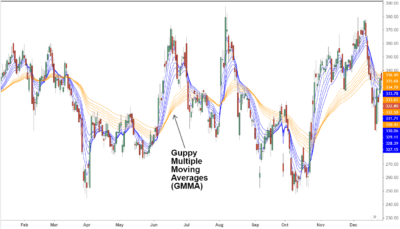Contents
The goal of using moving averages or the Moving Average Envelope is to identify trend changes. Among the first supporters of this countertrend strategy was Chester Keltner. Back in 1960, in his book How to Make Money in Commodity Markets, he described the idea of the Keltner Channels, using slightly more complex calculations. Instead of using the closing to calculate the Moving Average, it used a typical price, which is defined as the average of the high, low, and close.
When the bigger trend is up, oversold readings can be used to identify pullbacks to improve the risk-reward profile for a trade. Momentum turns bullish again when CCI moves back into positive territory . A Bollinger Band® is a momentum indicator used in technical analysis that depicts two standard deviations above and below a simple moving average. Moreover, the small flux variations from nonself-calibrated and self-calibrated continuum emission was always within the 10% uncertainty of the flux measurements. Hence in this case we decided to use the pipeline delivered images. Using this information, the trader can then trade within the range of price movement by selling on the upper envelope and buying at the lower envelope band.

When the security’s price touches the upper band and turns downward, the security might be at an overbought level. Conversely, when the security’s price touches the lower band and turns upward, the security might be at an oversold level (see “Too well-liked,” below). We have already discussed what problems arise with trading based on the Moving Average. To limit the number of losing trades, some technical analysts suggest adding the filter to the sliding ones. They add lines which are a certain distance above and below it, forming envelopes.
Band breakdown
When the RSI releases from the DC-RSI envelope, you can take the trade off. When there is a price between the upper line and the lower line of the envelope, the price is fixed on the upper and lower lines. And you can also set the percentage of profit or loss on the closing price. @How to use it You can see the performance through overview by modifying the percentage and profit and loss at…
Close your position when price returns to the upper band or crosses to below the moving average. IBM is charted withPercentage bands at 7% around a 30 day exponential moving average. If you are in search of a way to identify when an asset is overbought or oversold, you could try using the envelopes indicator. RSI Donchian Channels Built by Ricardo and JR Here is a great indicator to use for strong trends. Donchian Channels react immediately to changes in the highest high and lowest low. For strong trends you want to trade when RSI is set along the upper or lower DC-RSI envelope.

You must understand that Forex trading, while potentially profitable, can make you lose your money. Never trade with the money that you cannot afford to lose! If price closes below the bottom bound and seems to have truly broken support, you could sell, as there could be a downtrend beginning. You may see some confusing and seemingly contradictory instructions on how to use the What Is Bollinger Band? while you are trading.
If you notice that price has broken one of the lines and does not appear to be bouncing back, it could mean that a trend is forming in that direction. When price is ranging sideways, you will likewise see the envelopes moving more or less sideways as well rather than strongly upward or downward. Also, note that some envelopes indicators seem to plot with a mid-point SMA, displaying three lines.
Appendix D Complete velocity cubes
Covel shows why market prices contain all available information, and readers will learn how to interpret price movements and profit from trend following. This scan looks for stocks that broke below their lower exponential Moving Average Envelope twenty days ago to affirm or establish a downtrend. The current 10-period CCI is above +100 to indicate a short-term overbought condition. Members can also set up alerts to notify them when a Moving Average Envelope-based signal is triggered for a stock. Alerts use the same syntax as scans, so the sample scans below can be used as a starting point for setting up alerts as well. Simply copy the scan text and paste it into the Alert Criteria box in the Technical Alert Workbench.
At the same time, it does not require adjustment of parameters over time, it adjusts itself to volatility. In the chart of the QQQQ’s, after the price breakout, the closing price continued to close above the upper band; this is a good example of how a price trend begins. Even though Moving Average Envelopes are not used specifically in Thomas Carr’s Trend Trading for a Living, the book shows traders how to trade in the direction of the underlying trend. Carr also shows readers how to configure a bullish and bearish watch list from which to set your entry and exit prices. When the price moves above the upper envelope, this can be considered overbought.
The indicator includes three moving averages, but the average of them in many platforms for some reason is not applied. That is, in the general case, we recorded an impulse that broke something, and entered the breakdown side, counting on the continuation Reviews on LexaTrade of the movement. Such trading is very similar to the trend, but it is of a more short-term nature. Typically, this trade is characterized by the use of channels or local extremes. The entrance to the trades is mostly done by deferred stop orders.
- Moving average envelopes are similar to other technical indicators, such as Bollinger Bands and Keltner channels, except that these also vary the width of the bands/channels based on a volatility measure.
- Overbought moving average envelope readings can actually be a sign of strength during a strong uptrend.
- Moving-average envelopes offer a useful tool for spotting trends after they develop.
- A moving average envelope consists of a moving average AND two other lines.
- The 2.5% envelopes were touched several times, the 5% envelopes were only touched during the July surge.
A security’s volatility will also influence the parameters. Bollinger Bands and Keltner Channels have built-in mechanisms that automatically adjust to a security’s volatility. Bollinger Bands use the standard deviation to set bandwidth. Keltner Channels use the Average True Range to set channel width. Chartists must independently account for volatility when setting the Moving Average Envelopes. Securities with high volatility will require wider bands to encompass most price action.
FXSSI.TradingActivity
Because the stock was quite oversold after this sharp decline, it would have been prudent to wait for a bounce. We can then use basic price analysis or another momentum indicator to identify bounces. With DOW becoming overbought soon after establishing its uptrend, it was time to wait for a playable pullback. Traders can look for pullbacks with basic chart analysis or with indicators. Pullbacks often come in the form of falling flags or wedges.
We cover what a Moving Average Envelope is and how traders can use insights from this technical tool to create a better trading strategy with better-informed decisions. This technical analysis guide introduces you to Moving Average Envelopes. The Envelopes indicator can be a part of various trading strategies. For example, it may be used for scalping on small timeframes. As it’s a trend indicator, it’s possible to achieve good results by combining it with some oscillator. Michael Covel’s Trend Following introduces the fundamental concepts and techniques for a variety of trend following systems.
With a moving average as the base, Moving Average Envelopes can be used as a trend following indicator. Beyond simply trend following, though, the envelopes can also be used to identify overbought and oversold levels when the trend is relatively flat. This is a mathematically precise way of implementing envelopes to achieve a high number of winning trades because Bollinger Bands® are designed to contain 95% of the price action. In theory, moving-average envelopes work by not showing the buy or sell signal until the trend is established. Analysts reasoned that requiring a close of 5% above the moving average before going long should prevent the rapid whipsaw trades that are prone to losses. In practice, what they did was raise the whipsaw line; as it turned out, there were just as many whipsaws, but they occurred at different price levels.
Charting with Moving Average Envelopes
However, measuring overbought and oversold conditions is tricky. Even though one would expect an overbought stock to fall in price, securities can become overbought and remain overbought for some time during a strong uptrend. Similarly, securities in a strong downtrend can become oversold and remain oversold. In a strong uptrend, prices often move above the upper envelope and continue above this line. In fact, the upper envelope will rise as price continues above the upper envelope.
Moving Average Envelopes overlays based on either SMAs or EMAs can be added from the Chart Settings panel for your StockChartsACP chart. They are listed as “EMA Envelopes” and “SMA Envelopes” in the panel. Both types of Moving Average Envelopes can be overlaid on the security’s price plot or on an indicator panel. We introduce people to the world of trading currencies, both fiat and crypto, through our non-drowsy educational content and tools. We’re also a community of traders that support each other on our daily trading journey. Whenever price traded near the upper envelope, the price would fall back down.
Regarding the ejection, it is supposed to be intimately related with accretion (Hartigan et al. 1995). Observational parameters of the high resolution continuum emission obtained from ALMA archive. In the total power observations, the frequency setup was exactly the same as in the case of the interferometric observations. In this work we directly use the total power images delivered by ALMA. “Prescription for pain” shows Endo Pharma Holdings with the Moving Average Envelope of 20 and 10%. We used 10% in this example to show that bands needs to be adjusted based on the volatility of a stock.
Since trends often begin with a strong move, if the price surges above the upper envelope, this is considered bullish. And a simple Overview of FXCM Broker sell signal occurs when the price closes below the moving average. The goal of using moving averages is to identify trend changes.
